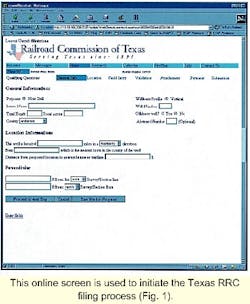Susan Cisco, Debbie LaHood
Railroad Commission of Texas
Austin
On May 11, the Railroad Commission of Texas (RRC) will introduce the Electronic Compliance and Approval Process (ECAP), an electronic commerce system that eliminates paper by capturing, storing, and transmitting oil or gas well permitting information electronically.
ECAP, developed through collaborative work among the US Department of Energy, industry representatives, and the RRC, expects to:
- Save $3-6 million annually.
- Improve communications.
- Streamline regulatory processes through the use of Internet-based technologies, relational databases, document imaging, and workflow software.
The problem
Permitting an oil or gas well is currently a linear, paper-based process.
First, a paper application form is filled out and signed by an applicant. It is then submitted with attachments and the applicable fee to the RRC where it is reviewed in a step-by-step process.
Because the necessary steps to approve a permit application are varied and handled by several organizational units, it takes 3-5 days to process a simple application manually. The approved permit must then be returned to the applicant by mail. A delay of 1-2 days in approving a permit application can cost an operator thousands of dollars because a permit must be posted at the drill site before drilling begins.
In addition to proving cumbersome and time consuming, the paper-based permit application process produces redundancies, as operators are asked to provide the same information more than once-operator name and address, operator number, well name, etc. RRC staff members must then rekey the typed or hand-written data from the paper forms into mainframe databases.
After keying, the paper forms are retained for 100 years. In a majority of cases, access to historical drilling-permit information requires retrieving the paper forms or going to a nearby RRC office to search the mainframe database.
Improving the process
In October 1998, Railroad Commissioners and staff met with industry representatives to quickly develop a permitting system for the purpose of increasing process efficiencies and to reduce industry and RRC costs. The group decided to first focus on electronic processing of the more than 150,000 oil and gas compliance permit applications filed annually.
A major challenge for such an ambitious project concerns dealing with the diversity of the industry that the RRC serves. In Texas, the RRC regulates nearly 9,000 active operators of all sizes, including independent and major integrated companies.
Additionally, there is daily contact with business consultants and information brokers as well as the general public and other information users.
Ideally, approving a permit would become a completely electronic process, from initial application through review and permit issuance. Four technological approaches were considered initially:
1. Electronic Data Interchange (EDI): EDI systems using X.12 formats were developed primarily to reduce the error rate associated with manual key entry and to bypass slow mail delivery by using private telecommunications networks (value-added network or VAN). They require special software on participants' computers, specialized translators, and complex transaction sets.
EDI can be expensive to implement and requires dedicated staff to maintain the system. The RRC has used a proprietary EDI system since the late 1970s to collect some operator reports; however, EDI was not selected as a solution to the permitting problem because it does not offer wide access, flexibility, and low cost.
2. E-mail routing: Using e-mail messages to exchange permit information is an attractive solution to the permitting problem because most industry and government workers have access to these systems. With this approach, the permit information would be contained in Microsoft Word or Excel attachments to e-mail messages, requiring specific software on the applicants' computer.
Additionally, other nontext items (scanned maps and digitized plats) submitted with the application do not have standardized formats in many e-mail systems and therefore cannot be transmitted. Finally, the reliability of e-mail is a serious issue since messages can get lost or delayed, and delivery is not guaranteed.
3. Off-the-shelf electronic forms software: There are at least a dozen electronic forms technology products available for sale. Typically, electronic forms are downloadable and eliminate the need for the data to be key entered twice by the sender and the receiver.
Like EDI systems, specific software would have to be loaded on participants' computers. Then as new software versions are introduced, computers would need to be updated. The RRC eliminated off-the-shelf software as a solution to the permitting problem because it did not offer wide access and had a high maintenance cost.
4. Internet-based routing: By use of the Internet for data entry of a permit application, submission to the RRC is electronic. The application review is carried out with workflow software upon which legacy databases are updated and permits are returned to applicants without the need for paper.
The cycle-time needed to process a permit or license can therefore be greatly shortened. A standard web-browser such as Microsoft Explorer or Netscape Navigator provides the user interface. The edit and calculation logic used for a specific transaction can be stored as part of the record, creating an audit trail.
Because the Internet offers ubiquitous access, low cost, flexibility, and a low barrier to entry, the RRC selected web-based routing as the best available technology solution to the permitting problem.
ECAP
The Internet-based technologies solution to the well-permitting problem, ECAP, will convert the filing, review, and approval of a well's drilling-permit application (Form W-1) to a completely electronic process. The drilling permit was selected for several reasons:
- It is the first step in the regulatory life-cycle of a well.
- It will require solutions to complex infrastructure problems such as security, authentication and certification requirements, electronic processing of fees, and electronic attachments that can then be applied to other electronic processes throughout the full regulatory and compliance life cycle of wells.
- It offers immediate economic benefits within a reasonably short period of time.
The drilling-permit application pilot project will be implemented in three phases:
The first phase, to be completed this month, will provide the infrastructure that allows for electronic filing and approval of basic applications, associated fees, and attachments.
ECAP Phase Two, expected to be complete in December 2000, will then expand the core system to include more-complex drilling permits, additional attachments, and reporting.
Finally, Phase Three, to be completed in September 2001, will complete the development of the pilot project, including complete integration with existing geographic information system and mainframe-computer platforms.
The end result will be a completely automated and streamlined workflow solution for the drilling-permit application process with modules in place to accommodate future project steps.
Planning, funding
Representatives from the RRC and industry formulated ECAP's system infrastructure through several joint-application design sessions. With the help of industry representatives, the RRC received a special appropriation of $1.4 million from the Texas Legislature. One-third of the total cost of the ECAP project is financed by a $700,000 contribution from the US Department of Energy.
With funding in place, six teams formed to plan, develop, and implement ECAP's pilot project:
- Project management team coordinates activities for the entire project.
- Business needs team develops data and workflow requirements needed for electronic filings from the perspective of internal and external business needs.
- Technical and security team builds the technology solutions and implements the infrastructure necessary to support requirements identified by the business needs team.
- Financial team manages the budget and financial reporting.
- Publicity and training team coordinates internal and external training requirements and publicity.
- Legal and records management team manages legal and records management issues.
Nearly all teams include industry partners, and team members coordinate their activities through meetings and the project-management control document (PMCD). The computer-based PMCD tracks budget updates, project timetable, deliverables, status reports, and lists of issues resolved as well as issues requiring resolution.
Technology tools
Conversion of the manual process of permitting an oil or gas well to a completely electronic process requires solutions to a large number of complex issues such as:
- Capturing the information submitted with an application, including plats and form attachments.
- Payment of fees.
- Security and authentication of the electronic transactions.
- Database interactions.
- Routing for review and internal workflow.
- Electronic approval of the permit.
- Convenient data access in an electronic format.
The solutions are being developed in-house with contract assistance. The technology tools include an Oracle relational database, a Web Objects application development environment, Java as the web programming language, and Legacy Objects to link necessary mainframe data in a legacy information management-system database to the Oracle database.
In future phases, ECAP will include automated workflow software, bridging software to automate the links between the Oracle and information management-system databases, and integration with the RRC's ESRI ARC/INFO geographic information system.
The security mechanism includes authentication against a directory service. The directory service will be implemented with an X.500 product. X.500 is an Internet standard that provides a global electronic directory of people and organizations that is available to anyone in the world with Internet access.
The directory service will handle the digital certificates and digital signatures necessary for automating two other RRC forms in the future: Organization Report (P-5) and Producer's Transportation Authority and Certificate of Compliance (P-4).
To file permit applications electronically, an operator needs a personal computer, standard web browser, Internet connection, and an image scanner for plats. Each of the nine RRC Oil and Gas Division district offices and the Austin office will have the necessary equipment available for electronic filings.
Filing electronically
Before filing the electronic permit, an operator must be authorized by completing a hard copy master electronic-filing agreement (MEFA). Both RRC and operator representatives must sign this agreement.
The operator's representative may be an officer or director of the corporation or an employee of the corporation authorized to approve and sign RRC Organization Reports (Form P-5s) on behalf of the corporation, partnership, or sole proprietorship. The signature of the operator's authorized representative on the agreement shall appear on all electronically filed forms.
Logging on to ECAP via the Internet requires a user identification (ID) code and a password. An initial user ID and password are issued to the operator's authorized representative upon approval of the MEFA. The authorized representative will then be able further to distribute security access to ECAP by assigning additional user IDs and passwords as needed.
ECAP leads the user through the appropriate steps to fill out the electronic form, including general information and well location (Fig. 1). The plat must be scanned and included with the filing.
Fees are automatically calculated and must be paid with a Visa or MasterCard credit card (Fig. 2). Once the ECAP filer is satisfied with the completed form, the application is submitted. Receipt of the submission by the RRC will be immediately acknowledged with an electronic message.
The status of each application can be tracked online (Fig. 3).
Then, at any time, the ECAP filer can check on the status of the submitted application by logging back on to ECAP (Fig. 3). Approval of electronically filed permit information will result in a reduction of 2-4 days in processing time that is currently required to approve an application submitted on paper.
Process improvements, benefits
The ECAP system encompasses the entire process of applying for and receiving an approved permit to drill an oil or gas well and provides an interactive exchange of information that will be far more efficient than the current paper process.
Information will be captured in electronic format, eliminating the need to rekey data. This reduces opportunities for error and accelerates permit issuance. Industry representatives forecast savings of up to $200/permit from electronic filing of the drilling permit applications in the pilot project.
With the implementation of ECAP, ongoing benefits to the RRC and realized efficiencies will allow internal resources to be refocused on more qualitative issues and concerns. In addition, ECAP will increase public access to valuable data because electronic transactions will be available on the RRC web site 24 hr a day, 7 days a week.
Resources expended on developing the ECAP system will provide the necessary framework for expansion to other electronic application processes and pave the way to a more-efficient regulatory environment for Texas. The full economic benefit of electronic permitting and report processing via the Internet could reach more than $17 million annually, based on 25% utilization by oil and gas operators.
By sharing its experiences and successes, Texas can become a model for other state and federal regulatory agencies.
Acknowledgment
This article was prepared with the support of the US Department of Energy under Award No. DE-FG26-99BC15183.
The authors-
Susan Cisco is the assistant director, Information Management Services, for the Oil & Gas Division for the Railroad Commission of Texas. She holds an MLS and PhD in library and information science from the University of Texas at Austin. She is a CRM (Certified Records Manager) and is a member of ARMA International.
Debbie LaHood is assistant director of the Railroad Commission of Texas, Oil & Gas Division's Permitting and Production Services section. Under her supervision, this group is responsible for permitting the drilling of oil and gas wells throughout the state and the assignment of production allowables for some 235,000 active oil and gas wells. During LaHood's 22 years with the Railroad Commission, she has held a number of management positions.







